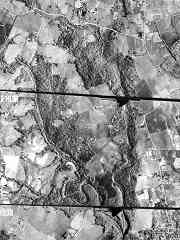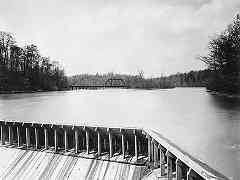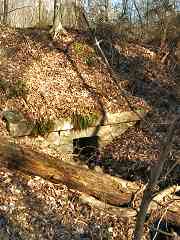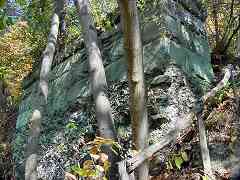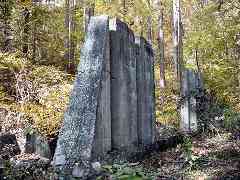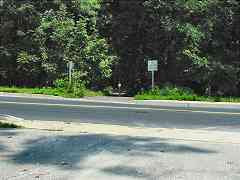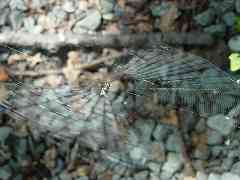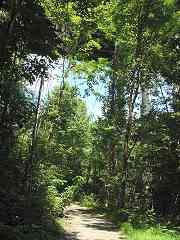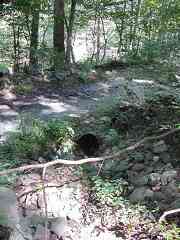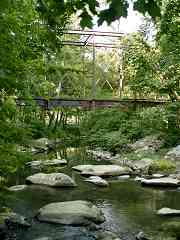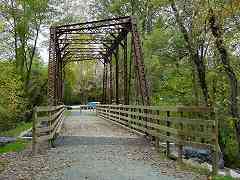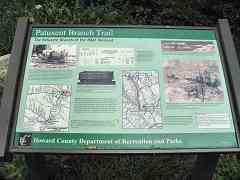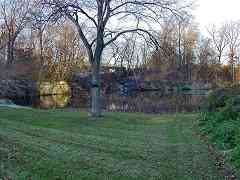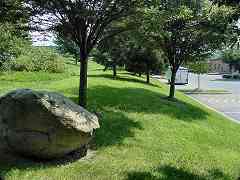|
The ROW continues northward, hugging the west bank of the Little
Patuxent River. Adjacent to the disused ROW and about midway between
the Gabbro Bridge and Vollmerhausen Road stand what had been puzzling
ruins that tower about 10 feet high. The mystery has since been solved.
Not seen in this picture is a parallel wall of equivalent height made
of stone rather than concrete.
The proximity to the ROW implies it was involved in railroad operations.
A coaling tower? This is a remote location for coaling. Might this
structure have been involved in water control for Savage Mill's dam
system? This idea doesn't fit well either because the mill's dam was
downstream.
Instead this structure was part of a quarrying operation run by W. T. Manning.
More information comes courtesy Ken Skrivseth, a volunteer at the
Laurel Historical Society that operates the Laurel Museum on Main Street:
"Back in the 1870's there was a cotton mill in Guilford MD, (probably a small
one), so I wonder if some of what you are seeing in your photos might be
from a mill dam or mill race from that time. We know about the Guilford
cotton mill because we have the diaries of the Laurel Cotton Mill
Superintendent from that period, and he (George H. Nye) would travel up to
'The Guilford' as he called it, from time to time, with mill supplies, or to
borrow supplies. I will dig through my notes and see what else I may have
on it. I think the mill operator at Guilford was named Heath, and there are
one or two Heath graves in Guilford at the Alberta Gary (see below) memorial
Methodist Church there along old Rt. 32. There is a map from 1878 (a
Hopkins Atlas) that shows the Guilford community - I'll try to find a copy,
as it will show whether or not there was a rail line back then and will
provide you with an idea of how big an operation they had there. From your
web pages I suppose that there was no rail line there yet, back in 1878.
"By the way, Alberta Gary was the daughter of James A Gary, president of
James A. Gary & Sons of Baltimore, which operated mills in Laurel, Alberton,
and Guilford, among possibly others."
Monica Fortner relayed info on signage in the area:
"The maps of Savage Park call your mystery structure a stone
finishing operation. My impression is that granite taken from the
nearby quarry was cut to desirable dimensions at teh stone finishing
operation and then loaded onto trains. The Park has identified large
metal coils on the hill above the mystery structure. The coils
supposedly held wood planks forming a water holding tank. There is also
a pipe leading from the water holding tank down towards the mystery
structure. The information on the kiosk at the Wincopin entrance to
Savage Park says that the water was used to cool the saws at the stone
finishing operation below."
During 2019 Wayne Davis wrote:
"I am working with the Maryland Historical Trust to expand the Savage and
Guilford Districts to include the stone crushers, etc. I also have that
photo showing the Gabbro Bridge (named for the Gabbro train stop whose
siding extended to almost on the bridge) - the abutments were made of
Guilford granite but the stone in the area being quarried was gabbro -
basically south of Vollmerhausen Road was gabbro and around Guilford it was
all granite."
Link:
historical info from Friends of Guilford
|
